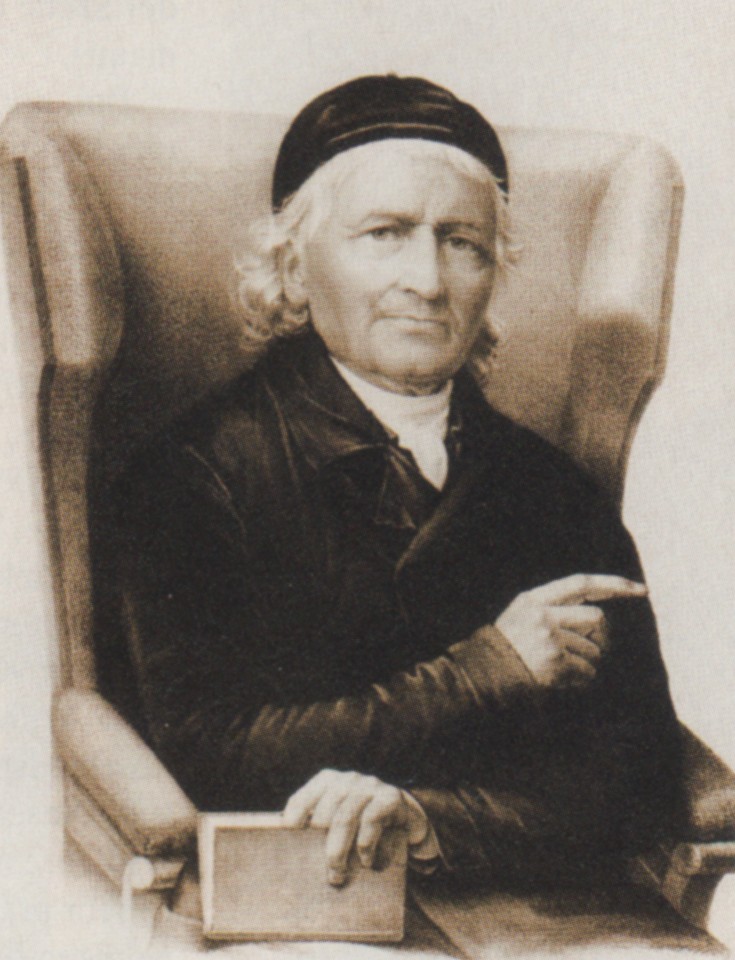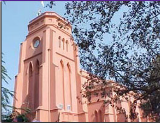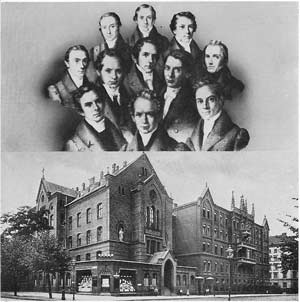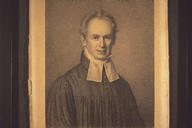Gossner (1836) and the Berlin Mission Societies
Because Berlin was home to three protestant mission training organisations, these are easily confused, when actually they stood in sometimes fierce competition with each other, one being old-Lutheran, one being aligned with the Lutheran state church (which condoned the persecution of old-Lutherans), and one attempting to be supra-confessional. All the divisions and rifts between Protestants in the mission field coalesced in Berlin. Jänicke established a missionary training institution in 1800 which was continued by (old-Lutheran) Rückert. The Berliner Missionsgesellschaft was formed in 1824 under the umbrella of the Prussian State Church, and the pietist Gossner Mission emerged in 1836.
The great century of missions
The Gossner Mission in Berlin was founded in 1836 during a period of religious revival and world political shifts establishing a string of similar institutions in Germany and elsewhere in Europe (1824 Berliner Missionsgesellschaft, 1825 Rheinische Missionsgesellschaft Barmen, 1836 Norddeutsche Missionsgesellschaft Hamburg, 1841 Neuendettelsauer Missionsgesellschaft, 1849 Hermannsburger Missionsgesellschaft). This was the ‘great century of missions’ among heathens, among migrants, and in the centres of industrial and social change at home.
The eventual success of the humble Gossner Mission society is astounding. Unlike the other mission societies founded to train missionaries, the Gossner Mission lacked proper organisation and association with a church and church regulations (Kirchenordnung), and was instead closely associated with the personality of its founder and his supra-confessional countenance (Überkonfessionaliät), and therefore retained his name.
Johannes Evangelista Gossner (1773–1858)
| Johannes Evangelista Gossner |
 |
|
Source: http://www.heiligenlexikon.de/ |
Johannes Gossner was 63 years old when he founded his missionary training institution. He had been a Catholic priest from Bavaria, with a somewhat free-thinking approach to the scriptures which brought him into conflict with the Catholic Church. He converted to Lutheranism in July 1826, and in 1829 became pastor of the Bethlehem church in Berlin, replacing Johannes Jänicke, who had himself founded a small missionary training institution in 1800. Jänicke merely trained missionaries for assignment by any mission society from any Protestant denomination.
Gossner was a founding member of the Berlin Mission Society in 1824 but resigned from its committee in 1836. This period gained him valuable experience and contacts and a thorough distaste for cumbersome bureaucracy. In 1834 he began to publish a mission journal Die Biene auf dem Missionsfeld (The bee on the mission field) which carried news and reports from missions around the world, directed at an audience of friends and supporters of missions, mission societies and their support societies (Hilfsvereine). He had good connections with Friedrich Spittler and the Basel Mission Society.
Beginnings
According to the Gossner Mission history, the training college commenced when six young artisans, who had been turned away by the admission rules of all other mission societies, came to Gossner in December 1836 wanting to be trained as lay missionaries. He agreed to train them himself – primarily in bible readings and hymn singing.
Four of the six artisans who seeded this idea in Gossner became part of the group sent to Zion Hill in Brisbane: Johann Gottfried Hausmann, Friedrich Franz, August Olbrecht, and Johann Gottfried Wagner. The other two were Johann Joachim Holzhausen and Karl Julius Zabel. When he had gathered an apostolic 12 candidates two weeks later, Gossner commenced to train them in December 1836.[1]
Like Jänicke, Gossner envisioned that they would then be taken on by other mission societies. Confessional boundaries were therefore unimportant for Gossner, who saw his lay missionaries as apostolic harbingers of the gospel, spreading the good word while fending for their own support in the image of Apostle Paul. Artisans and farmers were most suitable for such a vocation. The model for this vision was the Herrnhut Moravian community sending ‘colonists’ into the mission field to spread Christianity by example.
The supra-confessional outlook of the Gossner Mission was its strength, enabling it to collaborate with a wide range of mission societies and migrant communities, but it also caused some difficulties for its graduates who had little concern for the particular sensitivities of Lutherans, particularly old-Lutherans, with whom they had to collaborate.
Gossner missionaries in Australia
The first twelve of the Gossner missionaries were solemnly designated and farewelled on 9 July 1837 in a ceremony in the Bethlehem Church, having been accepted for assignment to Australia under the direction of J.D. Lang. The pioneers who set up the first Aboriginal mission in Queensland at Zion Hill, and became the first free settlers in Queensland, were also the very men who caused Gossner to commence a training institution.
This group was in every way an experiment. It basically emulated the Catholic model of sending a large group of Christians together to set up a self-contained community capable of attracting local interest. It was also a model premised on sending ‘colonists’, or lay-helpers, to surround one or two trained missionaries. This model was not repeated by Gossner, and became subject to an intense theological debate in the 1850s in the Berlin Mission Society when Harms at Hermannsburg again adopted it, and the Berliners considered revisiting it.[2]
By 1842 the German missionaries were out of favour with the colonial governments, but still Gossner sent more missionaries to Australia and the Pacific: Wilhelm Gehricke and Carl Gerler joined the Zion Hill mission in Moreton Bay, arriving in June 1844 together with August Richter and Johann Hermann who went on to the New Hebrides. Carl F. A. Schirmeister, who founded the Lutheran church in Brisbane in 1858, arrived in 1857 from a posting to the Chatham Islands Maori mission.
Gottfried Hausmann, who had been a member of the first Gossner party, sent his son John Haussmann (born 1840) to be trained by Gossner, and Haussmann Jnr. returned to Queensland in 1866 as an ordained priest to help his father establish Bethesda Mission at the Logan River, accompanied by T. Langebecker, W. Burghardt, and W. Guhr. All four went into ministry in the German communities in Queensland. [3]
Gossner Mission in India
From 1845 Gossner missionaries were directed to North India to Christianise Apasis (untouchables), and this became the major field of activity for Gossner candidates. Their missionising caused much hostility from the feudal lords, but received such good reception among Apasis that by the 1860s a church was starting to form in Chotanagpur and Assam.
| The Gossner church in Chotanagpur |
 |
| Source: North-Western Gossner Evangelical Lutheran Church, www.nwgelcyouth.org/ |
The unconfessional and unorganised nature of the mission society caused friction and split the Indian mission after Gossner’s death in 1858 because an administrative committee took charge in Berlin and developed organisational statutes, seeding the very bureaucracy which Gossner had resisted. The response in India was that most of the older Gossner candidates and some 3,000 Apasi Christians joined the Anglican Church under the Bishop of Calcutta, whereas the more recent Gossner graduates tended to remain loyal to the mission society. Still, the Gossner Mission Society continued to play an important role. From 1871 its director was K.H.C. Plath (1829-1901) who became a well-known pioneer missologist, arguing for a science of mission activity and its place in university teaching, and for a role in mission education in theological training.
The Gossner Mission gradually became more Lutheran and more bureaucratized until German missionaries were expelled from India during World War I, which led to the formation of an independent Indian church in 1919, the 'Gossner Evangelical Lutheran Church in Chotanagpur and Assam' (GELC). Between the wars the Gossner Mission in Berlin tried to claw back control over the GELC, but after World War II started to accept a partnership rather than a ‘one-way’ flow of ideas and directions.
In 1970 the Gossner Mission withdrew from its Indian field entirely, and there are no further Germans active in the Indian Gossner Church. The Gossner Mission focussed instead on Nepal and Zambia. It now sees its main activity as home mission in the industrial society, particularly in regard to migrants and other marginalised peoples.[4]
Competition: The Jänicke - Rückert school
Until the 1880s all of the German Protestant mission societies were dependent on Dutch and British (or Danish) contacts to place candidates in the colonies, and opportunities for funding by colonial governments were scarce. Competition between mission societies often rankled very bitter, and was increased under the pressures on Protestant churches to join the Union Church of Prussia in the 1830s.
| Berlin missionaries and the training institute |
 |
| Source: www.elcsant.org.za/ |
The first Protestant missionary training institute in Berlin was established by Jänicke in 1800 called ‘Evangelical Union for the Spread of Christianity among the Heathen’ (Gesellschaft zur Beförderung der evangelischen Missionen unter den Heiden).[5] In 1824 this name was adopted by a new mission society, which became the Berlin Mission Society in 1908.
However, after Jänicke’s death in 1826, J. W. Rückert tried to continue the Jänicke college, so that there were now two bodies in Berlin claiming to continue Jänicke’s project. Rückert was unable to obtain the state funding that had been allocated to Jänicke and ran into financial difficulties. Gossner was associated with the new body, and when he started his own institution ten years later, and obtained the backing of the Anglican Church Mission Society, Rückert saw him as his chief competitor. He called Gossner a ‘Catholic’, a ‘man of no denomination’, and
a propagandist who suffered himself to be employed in Berlin, as formerly he had done in Russia, Bavaria and other countries to attack us.[6]
Rückert argued that actually Gossner’s new college was not an institution at all, employing no teachers, whereas he himself employed six. He went so far as to say that ‘it is envy and malice and slander, to talk to you of two bodies existing in Berlin’. Rückert was livid that Gossner had been able to place all his new candidates through London in mid-1837.[7] He appealed to the London Missionary Society for financial support, arguing that his was a quality institution that had graduated ten missionaries in the last ten years, among them Tampe, Schürmann and Teichelmann (who became well known in Australia).
Our pupils are instructed by six teachers in Latin, Greek, Hebrew, English, History, Logic, Mathematics, Music and the several branches of theological knowledge. They live in my own house and are provided by a monthly allowance with all necessaries.
His second major enemy was the Prussian Lutheran Church, which had offered him half of the funding that had previously been assigned to the Jänicke school, if he placed his institution under its mantle.
But it is against all my conscience and you would commit the sin against the Holy Ghost, when you would not prevent our danger.[8]
He wanted the London Missionary Society to ‘limit the bad influence of the High Church’ by financially backing his school, similar to the arrangement the CMS had with the Basel mission society.
As I find the missionary institution at Basle have received for several years from the Church Missionary Society in England £ 900 for the maintenance and education of 9 students I have hoped that some arrangements of this kind, though not to that extent, may take place between our institution and your society.
Rückert felt that Gossner was a chief cause of his financial desolation. Not only had state funding ceased with the foundation of the society in which Gossner and Elsner (from the Basel Mission Society) were involved, but these two had also agitated against him:
two respected members of your Board have received representations to my prejudice from Mr. Elsner and the Catholic priest Gossner who have been the agents in the hand of the government of persecuting our nonconformist congregation and who have always endeavoured to injure our institution.
Rückert now felt besieged from all sides, ‘on one side Elsner and Gossner and on the other the union church party’ which was aligned with the Berlin Mission Society.
|
Dr C.F.A. Steinkopf of the German-Protestant |
 |
| Source: QS-30.008.0041 Basel Mission |
Also agitating against Rückert was Dr Carl Steinkopf in London. He was a member of the Church Mission Society (CMS) and the London Missionary Society (LMS) and organised their contacts with the Basel Mission Society and the Moravian brethren for whom he raised between £4,000 and £5,000 a year. He felt that Rückert’s institution had little to do with the one founded by Jänicke in 1800, and that it was driving pisions into the mission movement. Rückert defended himself against such allegations.
This gentlemen’s communication is of no value since he is the founder of all difference, when ever such still exists, according to his representations. It is true that he came in the year 1820 to Berlin, was liberally received by us – yet in the same time he asked not less than to stop our institution, and to establish a society for the benefit of that of Basel. ….. Since that time we have the pision in Missionarism, to which Mr Steinkopf alludes, but we had you may be sure, never to do anything with universalists and enthusiasts, and our missionary work is still not only in the same house from its beginnings 40 years go, but by the grace of Almighty it rests also still on the principles of unchanged faith and scriptural doctrine.[9]
Attacking the influential Steinkopf was clearly not a wise move, and indeed Rückert showed a remarkable absence of diplomacy, evidently out of tune with English ways. He ridiculed Dr Steinkopf and Dr Henderson in their involvement in the recruitment of Gossner missionaries in 1836:
Mr Steinkopf and Mr Henderson, … made a show in Fedder-Lane chapel by presenting so-said Missionaries who came from Berlin, taken from the street by their friend Mr Gossner, without any education – they were not sent by that body, which Mr Steinkopf, in opposition to us, favours, but by the man of no denomination.
Rev Sir, we know that we must go by many tribulations into the kingdom of heaven, but no good Christian has the right to prepare for us hardships hurting not our persons but the immediate cause of Christ’s kingdom itself.
Not surprisingly, the LMS declined to lend its support to someone who had so many enemies and such few friends. Dr Ebenezer Henderson (1784-1854), director of the LMS training college since 1825, must have taken exception to Rückert’s desparate comments, and passed on some of his letters to the Prussian bishop who in turn took exception. Rückert had cast the ‘high church’ as the arch-enemy, saying that he would rather remove his entire school to London than bow to the pressure of the Prussian church. The religious persecution of ‘old-Lutherans’ who refused to join the reformed union church in Prussia intensified. In 1843 Rückert wrote again to the LMS
for you must know that from principle I am one of yours, and that many of us for conscience sake worship at the present moment in caverns, forests and in habitable buildings and that some of them are afraid of persecution. [10]
In 1843 the LMS apparently offered to shelter him and his school in London. But Rückert had no intention of placing himself under the control of the LMS any more than under the union church. Henderson was known as a proponent of evangelical activity among Jewish people, and Rückert now portrayed his institution in Berlin as itself a mission that exerted evangelical influences on the Jewry of Berlin by exerting influence over the large population of university students university.
Rückert’s letters became increasingly ranting and rasping, and the London mission societies were clearly better served by working with a supra-confessional institution like Gossner’s, than with people trained in a highly dogmatic form of Lutheranism characterised by deep and fundamental pisions, which incidentally tore apart all Lutheran communities in Australia. Moreover, new institutions of a similar nature were getting formed in Barmen (1825), Hamburg (1836), Neuendettelsau (1841) and Hermannsburg (1849), and finally Herrnhut (1869). Jänicke’s Berlin school had been the first in Germany to train missionaries, but it had outlived its usefulness and Rückert died in 1854.
The old divisions arising out of the German Kirchenstreit have long been plastered over. The Jänicke/Rückert archives have been moved together with the Gossner archives into the Bethesda church complex of the Berlin Mission Society, and perhaps not altogether unsurprisingly, they are difficult to access.
Missionary training in Berlin
After Rückert’s death the Berlin Mission Society (BMS) and the Gossner Mission continued missionary training in Berlin. The BMS was far more demanding on its candidates than, for example the Moravians were at Herrnhut. There were eight academic subjects (six in theology plus German), and the three bible languages, with six full hours of teaching on most days.
Gesellschaft zur Beförderung der evangelischen Missionen unter den Heiden
Seminary training timetable 1855
| Monday | Tuesday | Wednesday | Thursday | Friday | Saturday | |
|
5.00 rise |
||||||
|
6.00 breakfast |
||||||
| 9.00 | Dogma | Dogma | Church History | Church History | Dogma | (church service) |
| 10.00 | Hebrew | Hebrew | Greek Grammar | Hebrew | Hebrew | Greek Grammar |
| 11.00 | Kathechesis | Bible studies | Libri symbolici | Bible studies | Libri symbolici | |
| 12.00 | ||||||
| 14.00 | German | Hebrew | ./. | Synopsis | German | ./. |
| 15.00 | Latin | Libri symbolici | ./. | Libri symbolici | Latin | ./. |
| 16.00 | Epistles | Greek | ./. | Greek | Epistles | ./. |
| 18.00-20.00 | Recitals |
Latin/ Church service |
./. | South African Mission | Recitals | ./. |
The Gossner missionaries, on the other hand, received fairly basic training, particularly while Gossner himself was in charge of the institution. His first group dispatched to Brisbane consisted only of lay-helpers, with one ordained priest who had received his theological training elsewhere. Clearly Rückert’s criticism of that institution had some justification. Gossner’s training represented a back-to-basics approach in view of the ballooning expectations that other seminaries were placing on their candidates, particularly in Berlin and Basel.
[1] Holsten, Walter, Johannes Evangelista Gossner – Glaube und Gemeinde, Göttingen, Vandehoeck und Ruprecht, 1949, p. 52.
[2] Berliner Missionsberichte Nr.11, 1858, p.167 (online)http://books.google.de/books?id=wNkhAAAAYAAJ&dq=Berliner+Missionsberichte&printsec=frontcover&source=bl&ots=wkU0Y7Ivem&sig=74zhrHOzomBa57Rb_1fKfCsPDLE&hl=de&ei=OF0SSvLXMYvs6gPz6Iy0Dg&sa=X&oi=book_result&ct=result&resnum=1#PPA1,M
[3]Lohe, M., ‘Pastor Haussmann and Mission Work from 1866’, Translation from Australischer Christenbote, Lutheran Archives, South Australia, 1964, p. 7. Theile, Otto, One hundred Years of the Lutheran Church in Queensland, LutheranChurch of Australia, Milton, 1938, p.268.
[4] Theile, Otto, One hundred Years of the Lutheran Church in Queensland, LutheranChurch of Australia, Milton, 1938, p.3. Gunson, W.N, ‘The Nundah Missionaries’ in The Royal Historical Society of Queensland Journal: Yearbook of proceedings, vol. 6, no. 3, 1960-1961 pp. 511-39. Annegret Smid, ‘Zur Geschichte der Gossner Mission’ Gossner Mission homepage accessed November 2008. http://www.gossner-mission.de/
[5]In the archives of the Berliner Missionsgesellschaft the file containing correspondence relating to Jänicke and Rückert (Signatur 572) is called ‚Gesellschaft zur Beförderung der evangel. Missionen unter den Heiden, founded in 1800 by Jänicke, continued under Rückert’.
[6] Rückert to LMS no date, probably 1843 (copy) , Berliner Missionsgesellschaft Archives, Bethanienkirche, Signatur 572.
[7] Rückert to LMS, 10. December 1838, Berliner Missionsgesellschaft Archives, Bethanienkirche, Signatur 572.
[8] Rückert, London, 5 December 1838, Berliner Missionsgesellschaft Archives, Bethanienkirche, Signatur 572 .
[9] From Berlin to Revd Josiah Pratt, Missionary Institution William Street 30, 31 December 1839, Berliner Missionsgesellschaft Archives, Bethanienkirche, Signatur 572 .
[10]Rückert to LMS no date, probably 1843 (copy), Berliner Missionsgesellschaft Archives, Bethanienkirche, Signatur 572.
